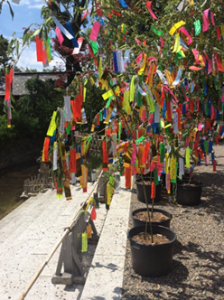Gravity(Attraction) of KyotoⅦ The Meaning of Tanabata, a Seasonal Summer Event
Yoshie Doi

July 2024 Kitano Tenmangu Shrine
Tanabata is on July 7 every year. It was originally an event brought over from China during the Nara period and was held on July 7 of the lunar calendar. Nowadays, it is often held in July.
January 1st
March 3rd,
May 5th,
July 7th
September 9th
These odd numbers are considered to be “yang” numbers in the ancient Chinese theory of Yin-Yang and the five elements, and are therefore considered to be auspicious.
There are various theories about why Tanabata is recited as “Tanabata,” but one theory goes back further in time and says that it is a Yamato word or Jomon word. During the Edo period, of the five seasonal festivals (January 7th (Jinjitsu), March 3rd (Joshi/Peach Festival), May 5th (Tango/Shobu Festival), July 7th (Shichiseki/Tanabata) and September 9th (Choyo/Chrysanthemum Festival), the Choyo no Sekku was the most public event. Samurai families would drink sake with chrysanthemum flowers dipped into the cup, while common people would cook millet rice to ward off evil spirits and pray for longevity.
The Tanabata event is a love story that has been passed down for hundreds of years, and it is an event about love. The origin of Tanabata is the Kikkoten ceremony, which worships the Cowherd (Kengyu) and the Weaver Maiden (Shukujo) and prays for improvement in the arts. This imperial court ritual spread to the general public and has been passed down ever since.
Originally, “Tanabata” was an old Japanese purification ceremony in which weavers would weave kimonos and place them on a shelf to welcome the gods and pray for a good harvest in the fall, thus purifying themselves of impurities.
The selected women were called “Tanabatatsume” and would retreat to weaving huts located near clean water such as rivers, where they would pour their hearts into weaving kimonos for the gods. The weaving loom used for this was called a
This legend was introduced to Buddhism and was passed down to the present day, linked to the purification ritual before Obon. It has lived on in people’s hearts, but in modern times it has come to be seen more as a day to make wishes. Originally it was a day for the rich and romantic story of Tanabata, but nowadays it is a day to hang strips of paper with wishes written on them on bamboo.
Why hang them on bamboo? Bamboo is believed to have a strong vitality and ward off evil spirits, as it remains green even in winter. It is also effective in repelling insects, and as bamboo grows quickly and grows straight up towards the sky, it was believed that it would deliver wishes to Orihime and Hikoboshi. Bamboo also has the effect of repelling insects, and in those days, bamboo was used to repel insects during rice cultivation, and it was believed that bamboo, which grows straight up towards the sky, would deliver wishes to Orihime and Hikoboshi in the sky.
Here is a poem from the Shin Kokin Wakashu:
He wrote and sent love letters over and over again, an endless number of times, but his wish has still not been fulfilled. (Fujiwara Toshinari)
The end of document
Translated by Masami Otani
